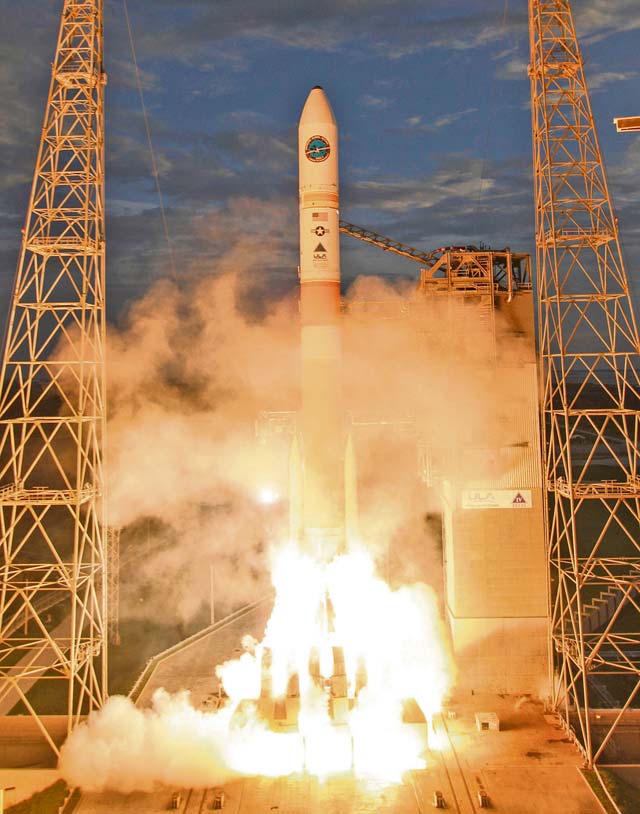
A Delta IV Medium+ (5, 4) rocket, carrying the seventh Wideband Global Satcom satellite aboard, lifts off from Cape Canaveral Air Force Station, Fla., July 23.
LOS ANGELES AIR FORCE BASE, Calif. — Five o’clock in the “City of Angels” typically signals the end of a day’s hard work. It’s a time when most Los Angeles metropolitan area commuters pile on to the freeways and the Metro Rail system, returning to their homes during the long summer evening.
However, about 25 dedicated Space and Missile Systems Center personnel put off their mad dash to jam the streets of LA, and instead, gathered in the Gordon Conference Center at the Schriever Space Complex. Instead of having visions of the weekend ahead, these active-duty and civilian employees observed the culmination of their efforts 2,584 miles away at Cape Canaveral Air Force Station, Fla.
Featuring a newly uprated Aerojet Rocketdyne RS-68A main engine for the first time on a rocket of its kind, a United Launch Alliance Delta IV Medium+ (5, 4) vehicle with a more than 16-foot wide, 47-foot long payload fairing and four solid fuel motors, soared from Space Launch Complex 37B at 8:07 p.m. EDT July 23. The vehicle carried the seventh Wideband Global Satcom satellite into a supersynchronous 36,000-mile transfer orbit. The Air Force communications satellite will join a constellation of WGS satellites already on station, providing global coverage to the U.S. military and its allies.
“This is the seventh installment of the WGS system,” said Ron Fortson, ULA’s director of mission management. “The satellites are an important element of a new, high-capacity comm system providing communications capability to our troops in the field.”
Meanwhile, back in California, the appreciative audience watched the launch as part of the eighth “SMC Launch Presents” event since 2014.
Hosted by Capt. Nick Laliberte, the government mission integration manager from SMC’s Launch Systems Directorate, these “launch and learn” sessions offer a prelaunch mission briefing and a Q-and-A session to explain what occurs during the countdown and the mission timeline in between the launch and satellite separation.
Just one week earlier a similar, although larger, audience of more than 150 SMC personnel gathered the morning of July 15 to watch the successful flight of a ULA Atlas V “401” launch vehicle carry the GPS IIF-10 satellite into orbit for the GPS navigation network. The fourth Atlas V launch of 2015 helped mark the 20th anniversary of the GPS constellation of satellites achieving full operational capability.
Launch managers were forced to scrub the WGS-7 mission the evening of July 22 for 24 hours, due to Florida’s notorious summer weather. The stormy forecast proved too worrisome to roll back the protective mobile service gantry and leave the vehicle exposed during the afternoon fueling session.
Weather forecasters from the 45th Space Wing expected heavy thunderstorms in the Cape Canaveral area for the July 23 attempt with anvil clouds and lightning being their primary concerns of violating launch criteria. Fortunately, the skies parted long enough for ULA’s medium-lift launch vehicle to do its job.
“It provides the highest data-rate communications for the government,” said Rico Attanasio, Boeing director of Military Satellite Communications.
Boeing is the builder of the WGS fleet, and ULA has launched all of the spacecraft to date. The satellites supply communications such as maps and data to Soldiers on the battlefield, relay video from unmanned aerial reconnaissance drones, route voice calls and data messaging; they even offer quality-of-life considerations like TV broadcasts and email delivery to the troops.
“The WGS constellation continues to provide significant added capacity to our (Defense Department) space communications architecture,” said Lt. Gen. Samuel Greaves, SMC commander and Air Force program executive officer for space. “WGS delivers crucial wideband communication to Soldiers, Sailors, Airmen, Marines and international partners around the globe. I am proud of the hard work and cooperation of the government and contractor teams on another successful WGS launch.”
With three more satellites in production, the WGS constellation plans to have a total of 10 satellites on orbit by 2018.


